Where to dig in?
Start with low-maintenance plants like pothos or snake plants that forgive neglect. You’ll need a few essentials: a watering can, moisture meter, and clean scissors for pruning. Check your home’s light conditions—south windows provide bright light while north-facing spots offer gentle illumination. Water only when the top inch of soil feels dry, and use well-draining pots to prevent root rot. Different plants require specific soil types, so match accordingly. The sections below reveal exactly how to help your green friends thrive.
Selecting the Perfect Starter Plants
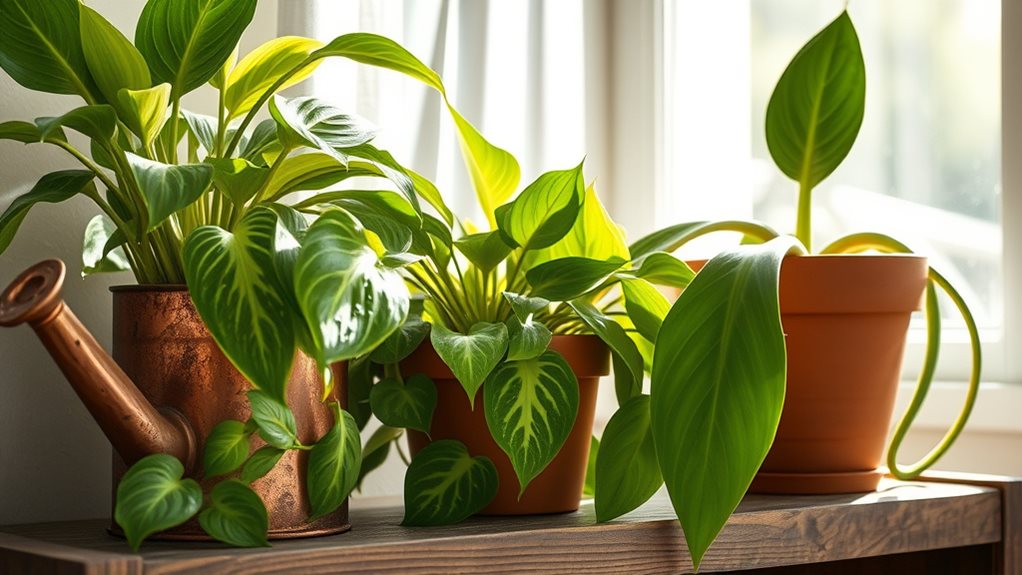
Every successful plant parent begins with the right plants, and choosing beginner-friendly varieties will set you up for success. Look for basic house plants that forgive your mistakes and adapt to various conditions in your home.
Starting with forgiving plant varieties creates a foundation for confidence and helps prevent early discouragement on your plant journey.
For your first plants, consider these top choices:
- Snake Plant – Thrives in low light and needs minimal watering
- ZZ Plant – Survives neglect and grows in nearly any light condition
- Heartleaf Philodendron – Adapts easily and signals when it needs water
- Cast Iron Plant – Lives up to its name with remarkable durability
- Monstera deliciosa – Grows quickly with distinctive leaves
These plants are affordable, widely available, and resist most pests. Many, like the Snake Plant, even purify your air while requiring little maintenance, making them perfect companions for new plant enthusiasts. Spider plants are excellent starter options that produce baby plants on long stems which can be easily propagated to expand your collection. Pothos is another excellent choice for beginners as it can tolerate neglect and still thrive in less than ideal growing conditions.
Essential Tools for Plant Parenthood
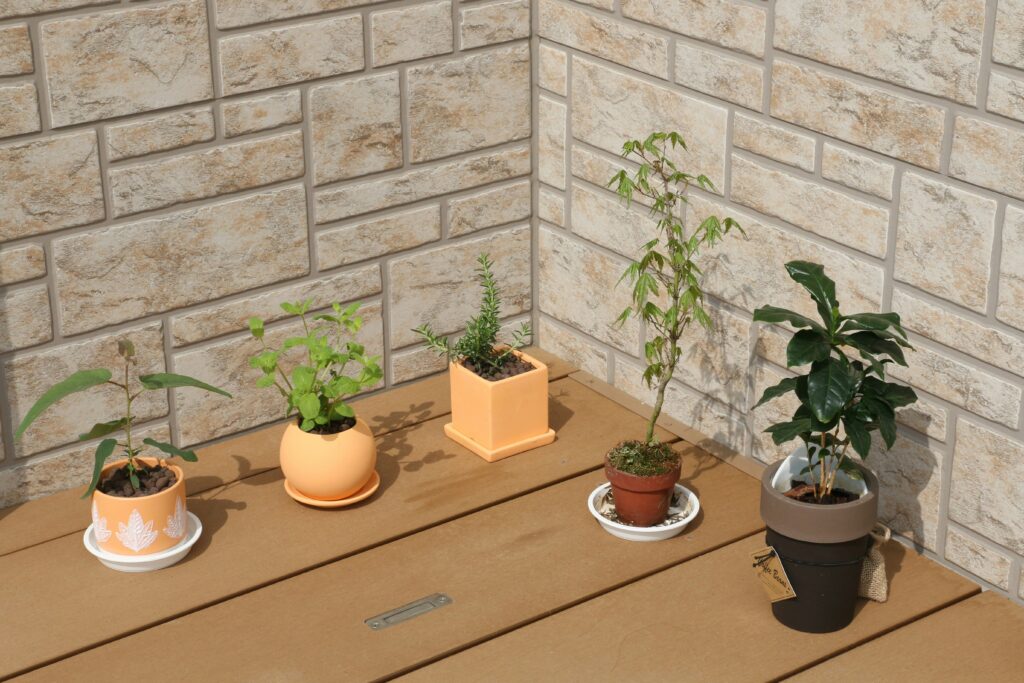
While your enthusiasm for plants is important, having the right tools will make your plant care journey much smoother and more successful. Start with the basics: quality watering tools, pruning scissors, and some monitoring devices to understand your plants’ needs. Self-watering hydrospikes are excellent for maintaining consistent moisture levels when you’re away from home. For more advanced gardeners, consider exploring soil-free systems that can reduce water usage and minimize pest issues.
| Tool Category | Essential Items | Why You Need It |
|---|---|---|
| Watering | Watering can with mister, moisture meter | Prevents overwatering, mimics rainfall |
| Cleaning | Soft cloth, olive oil black soap | Removes dust, enhances photosynthesis |
| Pruning | Sharp scissors, small shears | Makes clean cuts, prevents disease |
| Potting | Quality soil, well-draining pots | Provides nutrients, prevents root rot |
Remember to keep your tools clean between uses to avoid spreading potential diseases. You’ll find that these simple items transform your plant care routine from guesswork into confident nurturing.
Understanding Your Home’s Light Conditions
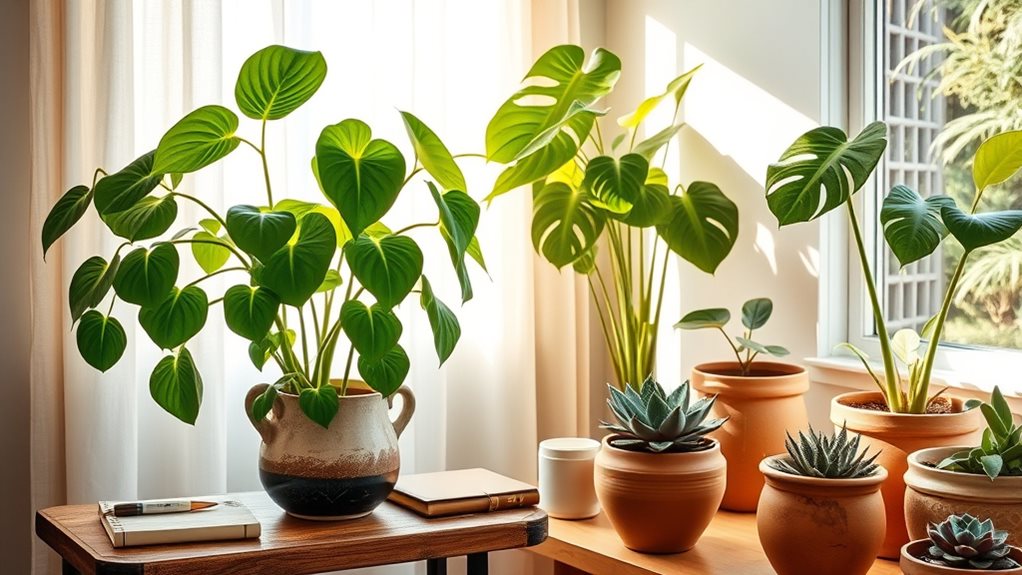
Since light is the foundation of plant health, identifying your home’s natural lighting conditions is your first step toward successful plant parenthood. Start by observing how sunlight moves through your space throughout the day, noting which areas receive direct rays and which remain in shadow. Window orientation greatly impacts available light—south-facing windows provide the most sun, while north-facing ones offer indirect light perfect for shade-lovers. Understanding these light conditions will help you determine which indoor plants can safely go outside during warmer months.
A south window’s intense light creates dancing patterns on your floor at midday. West windows fill rooms with golden afternoon light that stretches across walls. East-facing areas glow with gentle morning rays ideal for delicate foliage. North windows offer soft, diffused illumination that rarely creates harsh shadows.
Interior walls receive ambient light that changes subtly as the day progresses. Once you’ve mapped your lighting conditions, you can select plants that will thrive in your specific environment and choose potting soil that supports proper moisture retention and drainage based on their light needs.
Mastering the Art of Watering
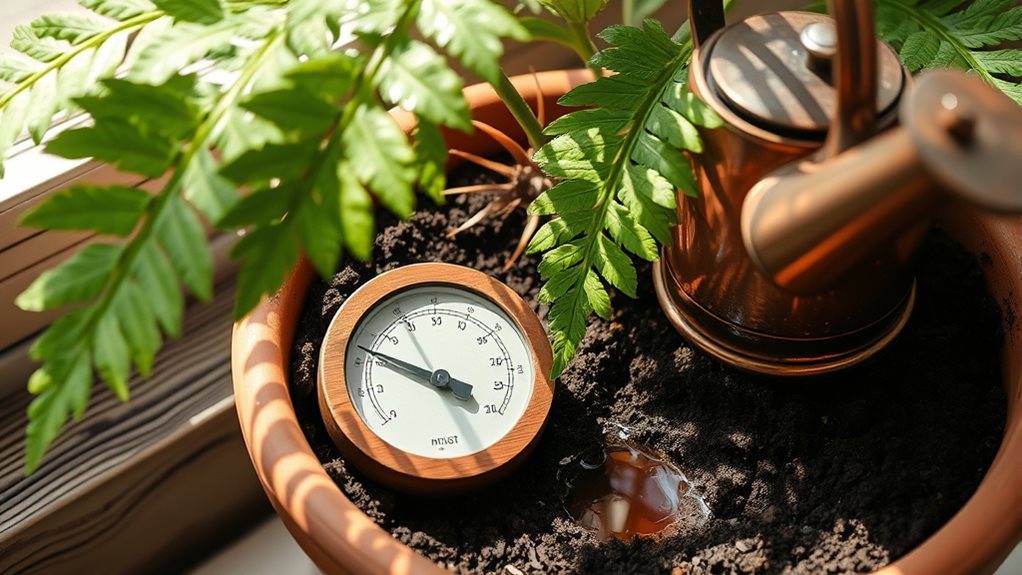
The perfect amount of water can make or break your plant’s health, turning a struggling specimen into a lush, thriving beauty. Instead of following rigid schedules, learn to read your plant’s unique needs.
Check soil moisture with your finger before watering—if the top inch feels dry, it’s time. For larger pots where your finger can’t reach the bottom, consider using moisture meters to accurately assess soil conditions. Water thoroughly until it drains from the bottom holes, ensuring roots are fully hydrated. Remember, your plants’ needs change with seasons; they’ll drink more during spring and summer growth periods and less in winter.
Watch for warning signs: droopy leaves often indicate overwatering, while crisp, dry foliage suggests thirst. Different plants have different requirements, so group similar ones together for easier care. Using specialized soil mixes with materials like perlite and vermiculite will significantly improve drainage and prevent water-related issues. Ultimately, flexibility and observation will guide you better than any strict watering calendar.
The Right Soil for Different Plant Types
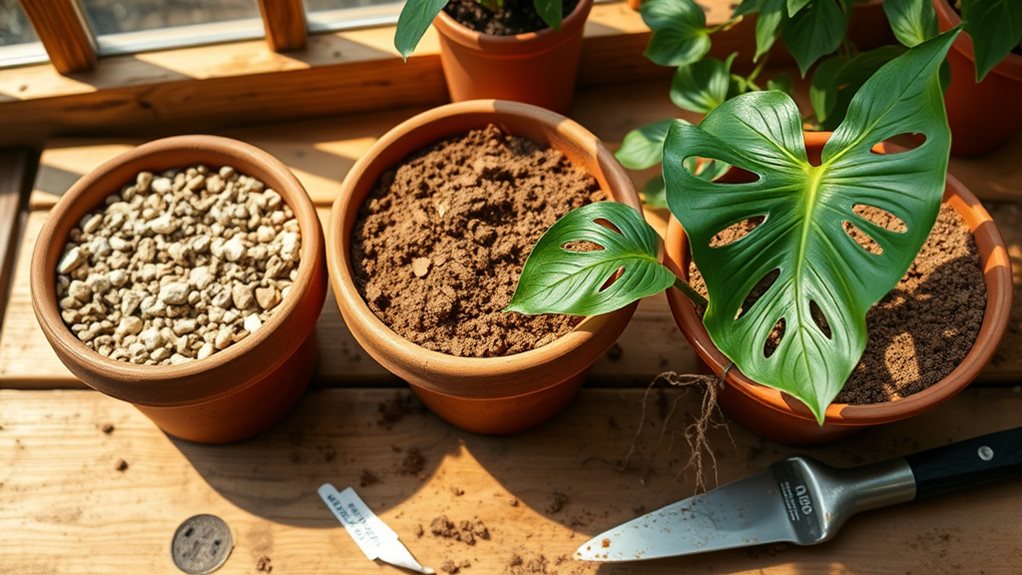
Choosing the right soil creates the foundation for healthy, thriving houseplants in your home. Different plants have specific soil needs based on their natural habitats, so matching them correctly makes a huge difference in their growth. Indoor plants need lighter, more well-draining soil than outdoor plants to prevent waterlogging and root rot.
Succulents and cacti thrive in sandy, fast-draining soil that mimics their arid native environments. Tropical plants need soil that retains some moisture but drains quickly to prevent soggy roots. Orchids require specialized bark-based mixes that allow air to reach their roots. General houseplants do well in loamy potting mixes with perlite for drainage. Acid-loving plants like ferns benefit from peat moss-enriched soil with a lower pH. Many indoor plant enthusiasts choose coconut coir as a sustainable alternative to traditional soil components due to its excellent moisture retention properties. When preparing houseplant soil, aim for a wrung-out sponge consistency that provides moisture without becoming waterlogged, similar to ideal seed-starting conditions.
Temperature and Humidity Considerations
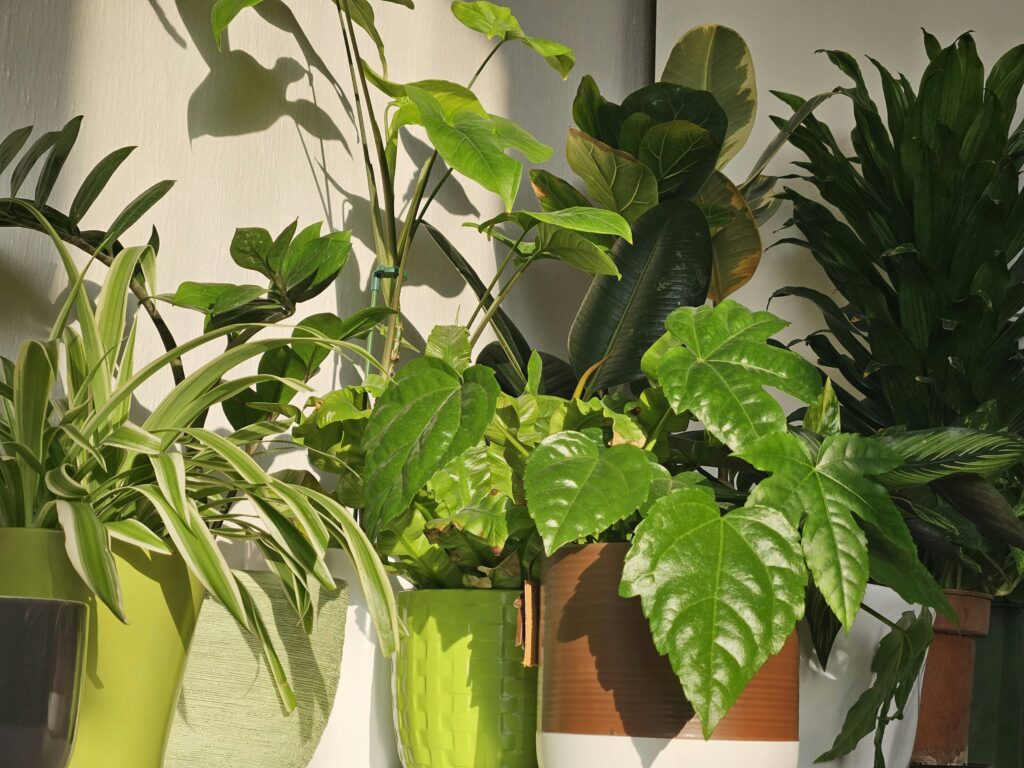
Beyond selecting the right soil for your plants, creating an appropriate climate in your home greatly impacts your houseplants’ health. Most houseplants thrive in temperatures between 18°C to 28°C (64°F to 82°F), similar to typical home conditions.
The indoor climate you create directly affects your plant’s ability to thrive, just as much as the soil you choose.
Temperature Management
- Maintain consistent temperatures, avoiding sudden fluctuations
- Keep foliage plants between 21°C-27°C during day and 15°C-20°C at night
- Position plants away from heating vents, air conditioners, and drafty windows
Humidity Needs
- Aim for humidity levels between 30%-50% for most plants
- Use a humidifier in dry environments, especially for tropical plants
- Group plants together to create a microclimate with higher humidity
- For flowering plants, maintaining lower night temperatures of about 13°C-16°C can enhance flower color and prolong blooming periods.
If you’re looking for plants that require minimal climate control, consider adding drought-tolerant species like snake plants, ZZ plants, or the Cuddly Cactus to your collection.
Seasonal Care Adjustments
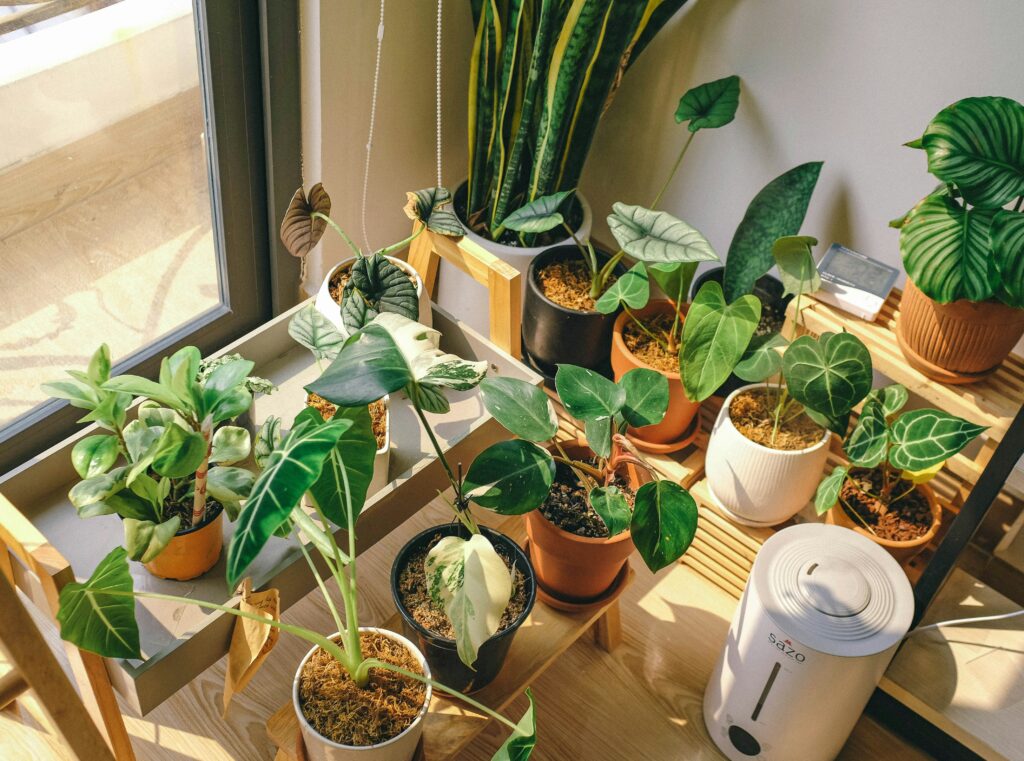
Just as you adjust your wardrobe with changing seasons, your houseplants need similar attention throughout the year. Most plants experience different growth rates as daylight and temperatures change, requiring you to modify your care routine accordingly.
When seasons shift, pay attention to your plants’ changing needs for water, light, and nutrients.
- Reposition your tropical plants away from cold windows during winter, protecting their sensitive leaves from frosty drafts
- Set up grow lights for sun-loving plants during darker winter months when daylight hours decrease
- Move humidity-loving plants to the bathroom during dry winter months to benefit from shower steam
Group plants together in summer to create a microclimate that retains moisture better. Reduce watering frequency by about 25-50% for most plants during their dormant winter period. Many beginners find themselves over-watering plants, which can lead to root rot and other serious problems, especially during winter months when plants need less moisture. Consider sketching a seasonal layout plan for your houseplants to ensure proper sunlight exposure and air circulation throughout the year.
Fertilizing for Healthy Growth
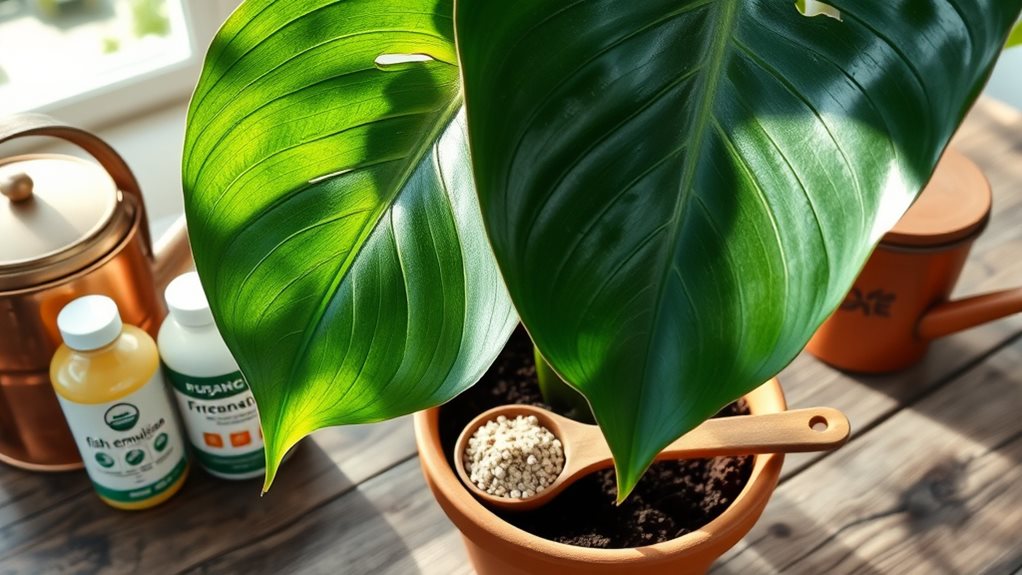
While many beginners tend to overlook fertilization, your houseplants need nutrients to thrive just as they’d receive in their natural habitats. Choose a balanced fertilizer with equal NPK ratios (like 10-10-10) for most houseplants, applying it during active growth periods from March through October. Potted plants exist in a closed system and cannot access external nutrients like plants in nature do. You can add nutrient-rich compost material to your potting mix to provide a natural alternative to commercial fertilizers.
Don’t skip fertilization—plants need nutrients to thrive just like they would in nature.
Timing and Application Tips:
- Fertilize every 1-2 months during spring and summer, reducing or stopping in fall and winter
- Always water plants thoroughly before fertilizing to prevent root burn
- Follow package instructions carefully to avoid over-fertilization
- Consider plant-specific needs—flowering plants benefit from higher phosphorus, while succulents need less nitrogen
Remember that consistent, moderate fertilization is better than occasional heavy doses, and different plants have unique requirements that you’ll learn with experience.
Common Pests and How to Combat Them
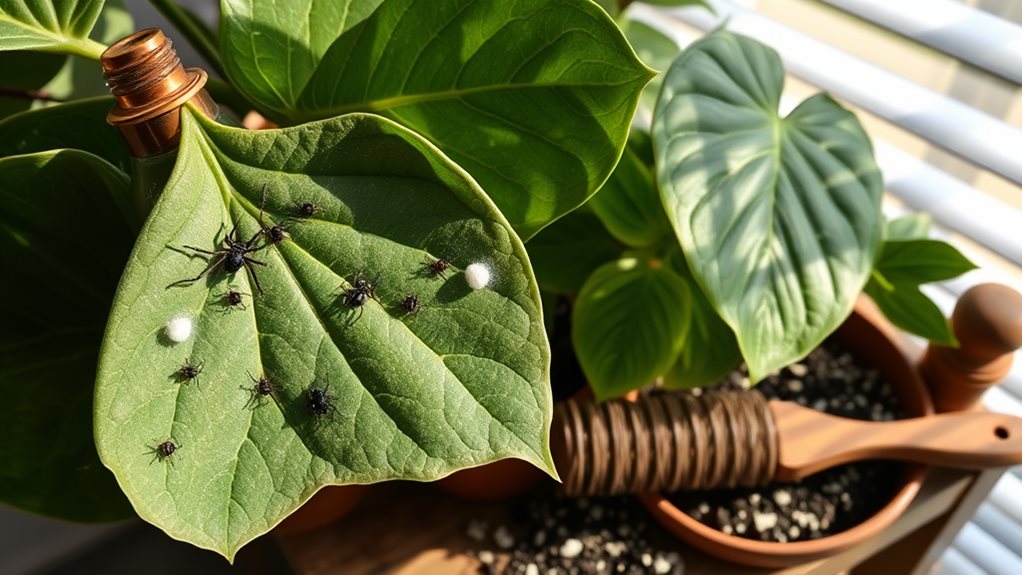
The arrival of unwanted pests can quickly turn your thriving houseplant collection into a struggling garden. Learning to identify and treat common invaders will save your green friends from decline. Check your plants weekly for signs of trouble, including yellowing leaves, sticky residue, or tiny movements on stems and leaves. Fungus gnats are particularly problematic when growing food indoors, as they can damage developing roots. Some gardeners are turning to hydroponic systems like AeroGarden that eliminate soil entirely, reducing the risk of soil-borne pests.
- Aphids cluster on new growth, leaving behind sticky honeydew that attracts ants
- Mealybugs appear as white, cotton-like patches hiding in leaf joints and stems
- Spider mites create fine webbing between leaves and cause tiny speckled damage
- Scale insects form immobile brown bumps that seem part of the plant itself
- Whiteflies scatter in small clouds when disturbed, then resettle on leaf undersides
For natural control, try wiping affected areas with alcohol-soaked cotton swabs or spraying with insecticidal soap. Quarantine new plants for two weeks before introducing them to your collection.
When and How to Repot Your Houseplants
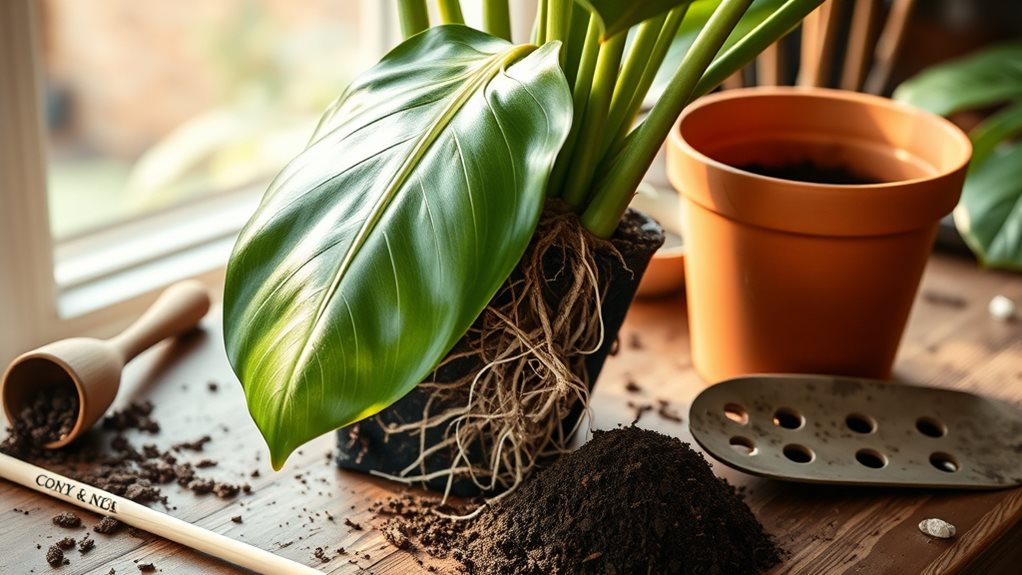
After defending your plants against pests, you’ll eventually need to address another houseplant challenge: repotting. Most plants need new homes every 1-3 years, with spring being the ideal time when they’re actively growing. Always use potting soil or compost rather than garden soil, which can be too heavy and may contain unwanted elements. For optimal growth conditions, a loamy soil mixture works best as it provides balanced drainage and moisture retention for most houseplants.
Repotting is another challenge in the plant parent journey, best tackled during spring when your green companions are in growth mode.
When to Repot
- Roots are growing out of drainage holes
- Plant growth has slowed despite proper care
- Water runs straight through without absorbing
Choosing the Right Pot
Select a container just 1-2 inches larger than the current one, with proper drainage holes. Water your plant the night before repotting to ease removal.
The Process
- Gently remove the plant from its old pot
- Loosen compacted roots with your fingers
- Place in new pot with fresh soil at the same height
- Water thoroughly and keep in low light for a week
Frequently Asked Questions
How Do I Revive a Dying Houseplant?
- Assess the plant by checking soil moisture, inspecting leaves, and looking for pests.
- Prune away dead parts with clean scissors, but leave some healthy foliage.
- Examine roots and repot in fresh soil if they’re rotted or crowded.
- Adjust your watering routine, giving the plant a thorough soak if it’s dry.
- Move your plant to proper lighting, avoiding harsh sun or deep shade.
Can Houseplants Be Toxic to Pets?
Yes, many houseplants can be toxic to pets. Sago Palms can cause liver failure, while lilies are especially dangerous to cats’ kidneys. You’ll need to be cautious with common varieties like Philodendron, Pothos, and Peace Lilies too.
Watch for symptoms like excessive drooling, vomiting, or lethargy after plant contact. Keep toxic plants out of your pet’s reach, or better yet, choose pet-safe alternatives. Always contact your vet immediately if you suspect your pet has ingested a toxic plant.
Why Are My Plant’s Leaves Turning Yellow?
Yellow leaves often indicate one of four common issues:
- Water problems: You’re either overwatering (soggy soil, mushy leaves) or underwatering (dry soil, wilting). Let soil dry partially between waterings.
- Nutrient deficiencies: Your plant may lack essential nutrients. Try a balanced fertilizer to replenish what’s missing.
- Pests or disease: Check under leaves for tiny invaders or signs of infection.
- Environmental stress: Consider light levels, temperature changes, or recent repotting as potential causes.
How Do I Prevent Mold on Soil Surface?
To prevent mold on your soil surface:
- Guarantee proper drainage by using well-draining potting mix and pots with drainage holes.
- Water only when the top 1-2 inches of soil feels dry, not on a fixed schedule.
- Improve air circulation around your plants with fans or proper spacing.
- Remove dead leaves and debris regularly.
- Sprinkle cinnamon on the soil surface as a natural fungicide.
- Allow soil to dry between waterings to discourage mold growth.
Should I Mist My Houseplants Regularly?
Misting needs vary by plant type. For tropical plants like orchids, ferns, and calatheas, mist 1-3 times weekly in the early morning.
Skip misting succulents, cacti, and fuzzy-leaved plants like African Violets as they’re prone to rot. Use filtered or distilled water to avoid mineral spots.
Conclusion
You’re now equipped with all the essentials of houseplant care! Remember, becoming a successful plant parent takes practice, patience, and observation. Start with forgiving varieties, maintain a consistent care routine, and don’t be discouraged by occasional setbacks. As you gain confidence, you’ll develop an intuition for what your plants need. With these fundamentals in place, you’ll soon transform your living space into a thriving indoor garden that brings joy year-round.

